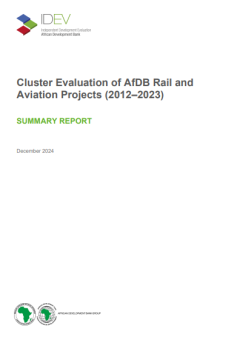
Cluster Evaluation of AfDB Rail and Aviation Projects
This evaluation complements the cluster evaluation of road and port projects, and together, they provide specific inputs to IDEV’s broader evaluation of the Bank’s support for the transport sector (2012-2023) as a whole. The evaluation examined the projects’ relevance, coherence, efficiency, effectiveness, and sustainability, and the additionality of five non-sovereign projects.
The evaluation noted that the rail and aviation projects were aligned to the relevant strategies and priorities of the Bank and other relevant entities, and the needs of its RMCs. The cluster projects exhibited robust synergies and interlinkages with other projects in the indicative operational program of the Country Strategy Papers and/or the existing portfolio of the two sub-sectors, particularly through their support for regional integration. Although cluster projects displayed mixed output results, the evaluation found direct benefits for users in terms of connectivity and operational efficiency and, where relevant, in improvements to safety. The Bank’s involvement in the non-sovereign operations was found to have reduced political risk, enhancing buy-in from commercial clients. Institutional capacity-building projects were less successful in achieving their outcomes. Most projects were favorably assessed regarding their use of financial resources, but challenges related to project design, monitoring objectives, capacity limitations of executing agencies, inflexible Bank processes and requirements, and ineffective coordination were found to result in long delivery delays. Most infrastructure designs appeared to reflect appropriate quality standards and adaptation elements. However, long-term financial sustainability, implementation capacity, and environmental and social safeguard issues were noted.
The evaluation identified key lessons to enhance project performance, demonstrate the Bank’s additionality, ensure long-term financial sustainability, implement a robust monitoring and evaluation system, and enforce adequate environmental, social, and operational safeguards.
